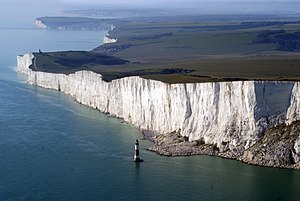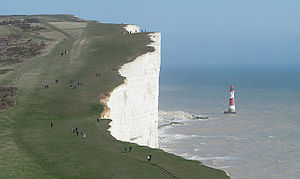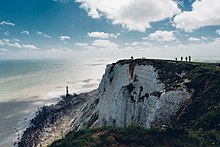geo.wikisort.org - Coast
Beachy Head is a chalk headland in East Sussex, England. It is situated close to Eastbourne, immediately east of the Seven Sisters.


Beachy Head is located within the administrative area of Eastbourne Borough Council which owns the land, forming part of the Eastbourne Downland Estate. The cliff is the highest chalk sea cliff in Britain, rising to 162 metres (531 ft) above sea level. The peak allows views of the south east coast towards Dungeness in the east, and to the Isle of Wight in the west.
Geology

The chalk was formed in the Late Cretaceous epoch, between 66 and 100 million years ago, when the area was under the sea. During the Cenozoic Era, the chalk was uplifted (see Cenozoic Era). When the last ice age ended, sea levels rose and the English Channel formed, cutting into the chalk to form the dramatic cliffs along the Sussex coast.
Wave action contributes towards the erosion of cliffs around Beachy Head, which experience frequent small rock falls. Since chalk forms in layers separated by contiguous bands of flints, the physical structure affects how the cliffs erode. Wave action undermines the lower cliffs, causing frequent slab failures – slabs from layers of chalk break off, undermining the upper parts of the cliffs, which eventually collapse.[1] In contrast to small rock falls, mass movements are less common. A mass movement happened in 2001 when, after a winter of heavy rain, the water had begun to seep into the cracks which had frozen and caused the cracks to widen. This then made the cliff edge erode and collapse into the sea, destroying a well-known chalk stack called the Devil's Chimney.[2]
History
The name Beachy Head appears as 'Beauchef' in 1274, becoming 'Beaucheif' by 1317, and it has nothing to do with the word "beach". Instead, it is a corruption of the original French words meaning "beautiful headland" (beau chef). It was being consistently called Beachy Head by 1724.[3][4]
In 1929, Eastbourne bought 4,000 acres (1,600 hectares) of land surrounding Beachy Head to save it from development at a cost of about £100,000 (equivalent to £6,467,710 in 2021).[5] This land became known as the Eastbourne Downland Estate.[citation needed]
The prominence of Beachy Head has made it a landmark for sailors in the English Channel. It is noted as such in the sea shanty Spanish Ladies:[6]
The first land we sighted was called the Dodman,
Next Rame Head off Plymouth, off Portsmouth the Wight;
We sailed by Beachy, by Fairlight and Dover,
And then we bore up for the South Foreland light.
The ashes of German social scientist and philosopher Friedrich Engels, one of the fathers of communism, were scattered off the cliffs at Beachy Head into the Channel, as he had requested.[3]
Human remains discovered in the 1950s were subjected to forensic reconstruction, carbon dating, and radioisotype analysis, and it was concluded that they were those of a Roman woman of Sub-Saharan African origin who grew up in the Eastbourne area in about 200–250 CE. She became known as Beachy Head Lady.[7][8][9] However, in 2021, DNA testing indicated she was of "southern European lineage, most likely from Cyprus".[10]
Lighthouse
The headland has been considered a danger to shipping. In 1831, construction began on the Belle Tout Lighthouse on the next headland west from Beachy Head. Because mist and low clouds could hide the light of Belle Tout, it was decommissioned in 1902, after the Beachy Head Lighthouse had been built in the sea below Beachy Head as a replacement.
At war
The third day of fighting in the Battle of Portland in 1653 took place off Beachy Head during the First Anglo-Dutch War. The Battle of Beachy Head in 1690 was a naval engagement during the Nine Years' War. The so-called Second Battle of Beachy Head took place over a week in September 1916 during the First World War. Three German U-boats sank 30 merchant ships between Beachy Head and the Eddystone. This was despite a major effort involving the Royal Navy and 49 destroyers, 48 torpedo boats, seven 'Q' ships and 468 auxiliaries.[11]
During the Second World War, the Royal Air Force (RAF) established a forward relay station at Beachy Head to improve radio communications with aircraft. In 1942, signals were picked up at Beachy Head which were identified as TV transmissions from the Eiffel Tower. The Germans had reactivated the pre-war TV transmitter and instituted a Franco-German service for military hospitals and VIPs in the Paris region. The RAF monitored these programmes, hoping (in vain) to gather intelligence from newsreels.[12] The area had an important wartime radar station. During the Cold War, a radar control centre was operational in an underground bunker from 1953 to 1957.[3]
Tourism
West from Belle Tout, the cliffs drop down to Birling Gap, then ascend through the Seven Sisters chalk cliffs to Haven Brow, overlooking the Cuckmere valley. The area is a popular tourist attraction. Birling Gap has a restaurant and, in the summer, multiple ice cream vans serve the area. There are many choices of walking routes.
Suicides


Estimates of the number of annual deaths at Beachy Head vary from 20 a year to many more.[13] In 2010, it was the third most common suicide spot in the world, after the Golden Gate Bridge in San Francisco and the Aokigahara Woods in Japan, according to The Wall Street Journal.[14]
The Beachy Head Chaplaincy Team conducts regular day and evening patrols of the area in attempts to locate and stop potential cliff jumpers. Workers at the pub and taxi drivers are also on the lookout for people contemplating suicide and there are signs with the telephone number of the Samaritans urging potential jumpers to call them.[15]
Deaths at the site are often covered by the media,[16] and Ross Hardy, the founder of the chaplaincy team, has said that this encourages suicidal people to choose the site.[15] Eastbourne Borough Council drew media coverage in 2018 for its policy of removing shrines and crosses left at Beachy Head by families of suicide victims.[17]
The earliest reports of deaths by suicide at Beachy Head come from the 7th century. Between 1965 and 1979, there were 124 deaths at the location. Of these, S. J. Surtees wrote that 115 of them were "almost certainly" suicides (although a coroner's verdict of suicide was recorded in only 58 cases), and that 61 percent of the victims were from outside East Sussex.[16] After a steady increase in deaths between 2002 and 2005, there were only seven fatalities in 2006, a marked decrease.[18] The Maritime and Coastguard Agency, whose Coastguard Rescue Teams are responsible for the rescue of injured jumpers and the recovery of the dead, attributed the reduction to the work of the Chaplaincy Team and good coverage of services by the local media.[18][19] At least 26 people died at the site in 2008.[20]
Use in entertainment and media
This section needs additional citations for verification. (October 2014) |
In film
The location Beachy Head has appeared in numerous films:
- It is featured in the climax of the 1931 film The Flying Fool, in which the villain's car is chased by the hero's plane over the cliffs. The car driven by the villain for the long chase sequence is a 4 1/2 litre Bentley belonging to Sir Henry (Tim) Birkin, whose private motor works was across the street from the studio in Welwyn Garden City that made the film. Captain Birkin's Motor Works, set up to develop the "blower" Bentley, built a dummy car from spare parts to be filmed falling from the cliffs.
- In the final scene of the 1947 film The Upturned Glass, the murderer, an eminent surgeon played by James Mason, commits suicide by stepping off the cliff.
- The area and lighthouse appear as a backdrop in the 1964 film The Chalk Garden, featuring Hayley Mills.
- It appears briefly in the 1968 film Chitty Chitty Bang Bang, when Chitty falls from it and then flies for the first time.
- The area is visible in aerial scenes of the 1969 film Battle of Britain when RAF Spitfires of Squadron Leader Canfield (Michael Caine) intercept German Stuka bombers.
- In the 1979 film Quadrophenia, the final scene shows Phil Daniels jumping off a scooter just before it goes over the top of Beachy Head.
- The 1980 film Hopscotch with Walter Matthau and Glenda Jackson has a flying scene that includes a mid-air explosion over the cliffs with the lighthouse in view below.
- The cliff appears in the opening sequence of the 1987 James Bond film The Living Daylights, in which Bond (portrayed for the first time by Timothy Dalton) parachutes from a Land Rover which drives off the top of the cliff in a scene scripted as being in Gibraltar.[21]
- In the 1989 film Henry V, the Prologue from Act II introducing the traitors was filmed at Beachy Head.
- In the 2005 film Harry Potter and the Goblet of Fire, Beachy Head was used as hosting grounds for the 1994 Quidditch World Cup.
- The area was used as a backdrop in many key scenes in Jenny Downham's 2007 young adult novel Before I Die and in its 2012 film adaptation directed by Ol Parker Now Is Good.
- The 2010 remake of Graham Greene's Brighton Rock was filmed extensively at Beachy Head as well as in nearby Eastbourne, which was preferred to Brighton.
- It appears in the 2017 film The Hitman's Bodyguard in the scene driving to Amsterdam. It shows both Beachy Head lighthouse and Bell Tout lighthouse, although Bell Tout had red and white stripes added by CGI.
- It is featured in the 2018 film Fantastic Beasts: The Crimes of Grindelwald, when Newt Scamander and his muggle friend Jacob Kowalski use an illegal portkey to teleport to France.[22]
In literature and publications
- Romantic poet Charlotte Smith's poem Beachy Head, published in 1807, uses the geography of Beachy Head to reflect on the history of England and human nature.
- Eastbourne born poet Andrew Franks includes a number of references to Beachy Head in his work, including Belle Tout in his collection, The Last of the Great British Traitors.
- In Howard Jacobson's 2010 Man Booker Prize-winning novel, The Finkler Question, the bereaved widower Libor Sevcik commits suicide by jumping off the cliff at Beachy Head.
- In Richard Jefferies' fine essay 'The Breeze on Beachy Head', first published in the 'Standard' on 6 September 1881 and collected in 'Nature Near London' in 1883.[23]
In music
- The cover photo of English avant-garde quartet Throbbing Gristle's 1979 record 20 Jazz Funk Greats was taken at Beachy Head. There is also a track named "Beachy Head" on the album.
- The location was used as the setting for the music video of the 1980 David Bowie song "Ashes to Ashes".
- The Cure used the location for the music video of their 1985 single "Close to Me (The Cure song)".
- The location is referenced in the song "Running Wild" on the album Undertow by the British band Drenge.
- Progressive Celtic rock band Iona included a song titled "Beachy Head" on their 1993 album, Beyond These Shores.
- Beachy Head was used as a film location for the video of 'Quello Che Faro', an operatic cover of Bryan Adams' "Everything I Do, I Do It For You", recorded by classical-crossover artist, Katherine Jenkins on her 2006 album, Serenade.
- Alternative rock band Nada Surf mentions Beachy Head in "The Fox", a song from their 2008 album Lucky.[24]
- British indie pop band Veronica Falls released a song titled "Beachy Head" urging people not to commit suicide in September 2010.
- Canadian band Stars included a song, "Palmistry," taking place at Beachy Head, on their 2022 album "From Capelton Hill."
In television
- Belle Tout Lighthouse and the surrounding area are shown throughout the 1986 BBC TV series The Life and Loves of a She-Devil.
- Beachy Head is seen in the fourth series of Luther, a drama on BBC TV.[25]
- Beachy Head and its lighthouse serve as a key location in the 7th episode of the British series The Prisoner.
- Beachy Head is featured in the first episode of the second series of Black Mirror, "Be Right Back".[26]
- Beachy Head was used as the location for a Monty Python sketch.
- Jeremy Clarkson performed a 50th birthday tribute for the Jaguar E Type on Beachy Head during an episode of Top Gear
- In the 17th December 2021 release of The Grand Tour, Beachy Head was filmed during the end of the episode of "Carnage a Trois" whilst Clarkson and Hammond were driving the Citroën SM
In technology
A photo of Beachy Head[27] was used as a desktop wallpaper on Windows 7.[28]
References
- "ALAN MACKENZIE".
- Cold, wet winter blamed for cliff collapse at Beachy Head, Michael McCarthy, The Independent, 5 April 2001 (retrieved 4 September 2020)
- Surtees, Dr John (1997). Beachy Head. Seaford: SB Publications. ISBN 978-1-85770-118-0.
- Ekwall, Eilert (1960). The Concise Oxford Dictionary of English Place-names (4th ed.). Oxford: Oxford University Press. ISBN 978-0-19-869103-7.
- Times, 30 October 1929. P. 11
- Palmer, Roy (1986). The Oxford Book of Sea Songs. Oxford: Oxford University Press. ISBN 978-0-19-214159-0.
- Miller, Ben (28 March 2014). "Beachy Head Lady was young sub-Saharan Roman with good teeth, say archaeologists – Culture24". Archived from the original on 30 January 2018. Retrieved 21 February 2017.
- "Centuries-old Beachy Head Lady's face revealed – BBC News". BBC Online. 1 February 2014. Retrieved 21 February 2017.
- Mintz, Zoe (4 February 2014). "Face Of 'Beachy Head Lady' Revealed, Roman Era Woman Is A 'Fantastic Discovery'". International Business Times. Retrieved 21 February 2017.
- "Story of Eastbourne celebrates first year with 23,000 visitors". 27 February 2020. Retrieved 12 November 2020.
- Reagan, Geoffrey. Military Anecdotes (1992) pp. 118 & 119, Guinness Publishing ISBN 0-85112-519-0
- Ockenden, Michael (April 1983). "TV Pictures from Occupied Paris". After the Battle. Battle of Britain Prints International (39).
- "Suicide jump child 'already dead'". BBC News Online. BBC. 2 June 2009. Retrieved 2 June 2009.
- Meaney, Thomas (15 April 2006). "Exiting Early". The Wall Street Journal. Retrieved 16 November 2010.
- Leitch, Luke. "Beachy Head: no ordinary beauty spot". The Times. 3 June 2009. Accessed 10 August 2011.
- Surtees, S. J. "Suicide and accidental death at Beachy Head." (subscription required). British Medical Journal 284 (6312): 321–324. 30 January 1982.
- "Council bans families of suicide victims from leaving shrines at Beachy Head". The Telegraph. 23 May 2018.
- "Beachy Head suicide numbers down". BBC News Online. BBC. 20 December 2006. Retrieved 2 June 2009.
- "Beachy Head Press Release". MCA Press Release. UK Maritime and Coastguard Agency. Archived from the original on 27 September 2007. Retrieved 2 June 2009.
- Smyth, Chris. "Man, woman and child found at foot of Beachy Head". The Times. 2 June 2009. Accessed 10 August 2011.
- "The Living Daylights (1987)" – via www.imdb.com.
- "Fantastic Beasts: The Crimes of Grindelwald at the Seven Sisters – filming location".
- 'Nature Near London' by Richard Jefferies was published by Chatto and Windus, in April 1883.
- "The Fox by Nada Surf Songfacts". www.songfacts.com.
- "New series of Luther comes to Beachy Head". www.eastbourneherald.co.uk. Archived from the original on 1 October 2017. Retrieved 9 February 2016.
- "Black Mirror Season 2, Episode 1". www.culturefly.com. 15 February 2013.
- "Beachy Head: England's Most Spectacular White Cliffs". Passport Collective. 4 October 2018. Retrieved 13 November 2019.
- Trenholm, Richard. "Windows 7 world tour wallpapers". CNET. CNET. Retrieved 27 January 2021.
External links
- Beachy Head, Eastbourne website
- Beachy Head walk to East Dean
- Beachy Head Chaplaincy Team
- Beachy Head Countryside Centre
- Online video of Broekhoven's film
- Landslides at Beachy Head British Geological Survey
На других языках
[de] Beachy Head
Beachy Head ist eine Landspitze an der englischen Südküste in der Nähe der Stadt Eastbourne in East Sussex. Der Kreidefelsen, Teil der South Downs, ist mit 162 m über dem Meeresspiegel der höchste in Großbritannien. Ihm schließen sich die Seven Sisters genannten sieben weiteren Kreideklippen an.- [en] Beachy Head
[es] Cabo Beachy
El Cabeza de Playa Tiza del Acantilado o Cabo Beachy (en inglés: Beachy Head Chalk Cliff) es un promontorio calcáreo en la costa sur de Inglaterra (Reino Unido), junto a la ciudad de Eastbourne en el condado de Sussex Oriental. Es el promontorio calizo más alto de Gran Bretaña, llegando a los 162 metros sobre el nivel del mar. La cima permite vistas desde Dungeness, en el este, hasta Selsey Bill, en el oeste. Su altitud también lo ha convertido en el lugar para suicidios más famoso y probablemente el utilizado más a menudo, de Gran Bretaña.[it] Beachy Head
Beachy Head è un promontorio calcareo sulla costa Sud dell'Inghilterra, più precisamente nel distretto di Eastbourne della contea di East Sussex. Si trova nelle vicinanze della città di Eastbourne ed immediatamente ad est della scogliera conosciuta come Seven Sisters. L'area al di sopra della scogliera fa parte del Downland Country Park amministrato dal Consiglio del distretto di Eastbourne. La falesia è soggetta a frane dovute all'erosione della roccia calcare, che comportano il continuo arretramento della scogliera.[ru] Бичи-Хед
Бичи-Хед (англ. Beachy Head) — мыс на южном побережье Великобритании.Другой контент может иметь иную лицензию. Перед использованием материалов сайта WikiSort.org внимательно изучите правила лицензирования конкретных элементов наполнения сайта.
WikiSort.org - проект по пересортировке и дополнению контента Википедии
